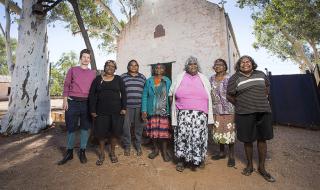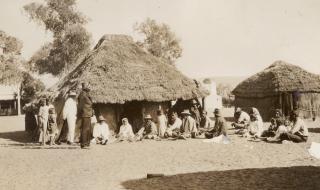The Hermannsburg Historic Precinct is included on the National Heritage List under criterion a), b), d) and h). It was entered on the list on Thursday, 13 April 2006 (see Commonwealth of Australia Gazette No. S 56, Thursday, 13 April 2006). The National Heritage List is Australia’s list of natural, historic and Indigenous places of outstanding significance to the nation.
The listing recognises the importance of the place to Australia’s history and in reflecting the following values:
(a) the place has outstanding heritage value to the nation because of the place's importance in the course, or pattern, of Australia's natural or cultural history.
Hermannsburg Mission was established by German Lutheran missionaries in 1877 at the forefront of pastoral expansion in central Australia. It is important as the last surviving mission developed by missionaries from the Hermannsburg Missionary Society in Germany under the influence of the German Lutheran community in South Australia. This community developed from 1839 in the Adelaide Hills and the Barossa Valley with the support of the South Australia Company, and in particular George Fife Angas. The influence of German Lutheran pastors and German tradesmen is expressed in the planning and layout of the mission, and in the design and construction of masonry buildings within the Historic Precinct.
Hermannsburg Mission, managed by Lutheran missionaries and the Lutheran Church from 1877-1982, is one of the longest serving denominational missions in Australia. Its history, expressed through the structures and landscaping which are a feature of the Historic Precinct, reflects several phases of missionary and government policy towards Aboriginal people spanning 105 years, from intervention to protectionist policies, assimilation and finally self-determination. The mission functioned as a refuge for Aboriginal people during the violent frontier conflict that was a feature of early pastoral settlement in central Australia. The Lutheran missionaries played a key role in attempting to mediate conflict between pastoralists, the police and Aboriginal people, and spoke out publicly about the violence, sparking heated national debate. The Lutheran missionaries were outspoken and independent, resisting government attempts in the early 1900s to close the mission and sourcing independent funds when the government temporarily withdrew its financial support following WWI. The Kaporilja Tank and connecting pipes were constructed using donated funds.
The Hermannsburg Historic Precinct, in the context of twentieth century development and overlays, is important in illustrating the progressive establishment, self-sufficiency and operation of remote, denominational, evangelical bush missions in central Australia, as well as the impact of Lutheran missionaries. The Historic Precinct, focused on an altered village green layout and flanked by gardens, includes buildings and structures which relate to the following development periods:
- 1877-1891 - Smithy, Colonists Residence and Manse;
- 1894-1922 - Meat house, Schoolhouse, Correspondence School, Strehlow’s House, Old Church, Mess house/Ration Store, Boy’s Dormitory, Wagon Shed Wall, Storehouse Ruin, Stockmen’s Residence and Stockmen’s Outbuilding; and
- 1926-1946 – Underground water tanks, Kaporilja Tank, Maid’s Quarters, Mortuary, Tannery, Kitchen, Bakery and Dining Room and Isolation Ward.
(b) the place has outstanding heritage value to the nation because of the place's possession of uncommon, rare or endangered aspects of Australia's natural or cultural history.
The Hermannsburg Historic Precinct is one of the few surviving relatively intact mid-to-late nineteenth century denominational, evangelical bush mission station complexes in Australia. It contains a rare suite of features which enable the development of such missions and their associated Aboriginal communities to be illustrated, such as the notional ‘village’ green layout, the dominance of church and school, and the planning alignments dictated by the need to reflect church layout.
Individual buildings illustrate the provision of accommodation for German pastors, lay colonists and Aboriginal people, and other operational functions of the mission.
Hermannsburg Mission is also the only surviving relatively intact nineteenth century Lutheran mission. The influence of German pastors and tradesmen of German origin in South Australia (1877-1922) is clearly visible in the planning and layout of the mission, and in the design and construction of the masonry buildings. Residential buildings incorporate features of traditional German farmhouses, also seen in German Lutheran settlements in South Australia. These features include gable ventilators and internal cross-wall construction based on German fachwerk techniques. The Colonists Residence and the Manse, erected 1877-1891, are particularly important in demonstrating these features.
The mission operated for 105 years and is the longest-running Aboriginal mission within Australia that was both continually managed by a denominational body, and that operated as a separate Aboriginal settlement throughout its history.
(d) the place has outstanding heritage value to the nation because of the place's importance in demonstrating the principal characteristics of:
(i) a class of Australia's natural or cultural places; or
(ii) a class of Australia's natural or cultural environments.
The Hermannsburg Historic Precinct represents one of the few mid- to late nineteenth century, denominational, evangelical mission stations in Australia which have survived relatively intact and which enable the principal characteristics of bush missions to be illustrated. These characteristics include:
- planning and layout, reflecting the major cardinal axes, in which the planning was based on a modified ‘village green’ layout, bordered by residential buildings and communal facilities, including a school and eating house, and a central, dominant church. This layout reflects the inward-looking nature of the community, and the centrality of Church and school to Lutheran communities;
- the self-sufficient nature of the former gardens and date palm grove and carefully engineered water supply system typical of remote missions and pastoral homesteads;
- a range of small-scale, residential accommodation erected from 1877, which illustrates the nature of accommodation erected and used by German Lutheran missionaries and lay colonists. These include the Colonists Residence and the Manse erected in the period 1877 –1891, and Strehlow’s House erected after 1894;
- the Schoolhouse, Boy’s Dormitory accommodation, Mess house/ration store, Old Church and housing (various buildings) erected under Strehlow (1894-1922), which illustrate the incorporation of Aboriginal people into both the pastoral and doctrinal functioning of the mission station;
- items associated with the Old Church, including a wooden tabernacle and the church bell, illustrating the religious nature of the mission.
These features also illustrate some of the common themes of Aboriginal mission life in the late 1800s and early 1900s and the social structures that existed, such as the distribution of rations, communal meals for Aboriginal people, the separation of Aboriginal children from their parents, and a strong emphasis by the missionaries, in particular the Lutherans, on church, schooling, work and self-sufficiency.
(h) the place has outstanding heritage value to the nation because of the place's special association with the life or works of a person, or group of persons, of importance in Australia's natural or cultural history.
Albert Namatjira Hermannsburg Historic Precinct has a special association with Albert Namatjira and Aboriginal artists who paint in the watercolour tradition. Namatjira’s importance lies in his development of a distinctive Aboriginal school of Central Australian landscape painting executed in watercolour. He was the first Aboriginal artist to be commercially exhibited nationally and internationally. Namatjiras’ work became widely acclaimed and a national symbol for Aboriginal achievement.
Namatjira grew up at Hermannsburg Mission, and the mission was pivotal to Namatjira’s development as an artist. His first experience in art for commercial return occurred at the mission, and in the early 1930s Namatjira was introduced to European style watercolour painting during artist Rex Battarbee’s visit to Hermannsburg Mission. The Lutheran missionaries at Hermannsburg played an important part in supporting and promoting Namatjira’s early artwork and managing his affairs.
Namatjira maintained a close association with Hermannsburg Mission throughout his later artistic career, frequently returning to the mission for periods of time. Aboriginal artists from other family groups in this area continue to paint in the watercolour tradition today.
Carl T. G. Strehlow and Theodore G. H. Strehlow Lutheran missionaries based at Hermannsburg Mission have made a singular contribution to the record of Aboriginal traditions through their work in this region.
Pastor Carl Strehlow was a scholar and skilled linguist whose early research with the Western Arrarnta and Luritja people in Central Australia over a 30-year period made a landmark contribution to the development of anthropology as a comparative discipline. His main work Die Aranda – und Lorita-Stamme in Zentral Australien adds to the early anthropological work of W. B. Spencer and F. J. Gillen on the Arrernte. Disagreements between the Lutheran Strehlow and the secular anthropologists set the scene for conflict over the interpretation of Aboriginal beliefs and traditions and over Aboriginal policy throughout the later twentieth century. Carl Strehlow’s missionary posting at Hermannsburg Mission and the relationships he formed with Aboriginal people in the region were fundamental to his work and key elements in the enduring Lutheran perspective on Aboriginal affairs.
This work was consolidated and developed by T. G. H. Strehlow, Carl Strehlows’ son. His knowledge of Arrarnta language and custom began with his early life at the mission, allowing him to develop the close relationships with Aboriginal people that were crucial throughout his career. He became a skilled linguist and was acknowledged as the leading anthropologist of Central Australia based on his intimate knowledge of Arrarnta religious life and traditions. Hermannsburg Mission provided a base for much of his fieldwork, and many of his most important informants were associated with the mission.
The Strehlows and other Lutherans based at Hermannsburg left one of the most comprehensive and detailed records of an Australian Aboriginal people. In Australian anthropology and Aboriginal policy circles T. G. H. Strehlow was regarded as an authority on Central Australia, and the positions he adopted on Aboriginal issues continued a strain of Lutheran non-conformity that developed at Hermannsburg Mission.
For further information on the national listing of Hermannsburg Historic Place






